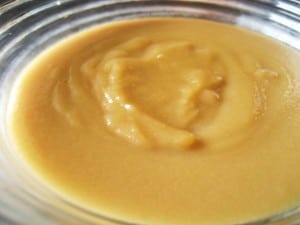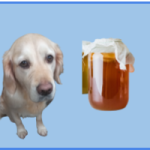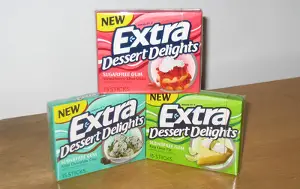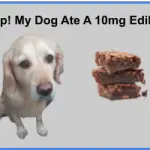
Let’s be honest, butterscotch in all its forms is a delicious treat.. I know that I myself like it as a hard candy, as a soft chew and even as a warm topping on ice cream.
Like many of the other treats that we enjoy, we may find ourselves wanting to share butterscotch with our four-legged friends.
But because we love them, we want to make sure it’s safe for them to eat.
So, let’s take a closer look at butterscotch, what it’s made from, what it’s found in and if it is safe for dogs to eat. Remember, we do this research because we love our best friends.
What is Butterscotch made from?
Butterscotch is surprisingly easy to make. It requires butter, brown sugar, salt, heavy cream and vanilla extract.
When you break down the ingredients, the only one that is a real danger to dogs is vanilla extract. Vanilla extract is a very concentrated form of the vanilla bean and contains alcohol.
If your dog should ingest pure vanilla extract, they could get sick from the concentration of alcohol.
Some symptoms to look out for if your dog ingests vanilla extract is diarrhea, disorientation, vomiting, slowing heart rate, lethargy, dehydration and seizures.
There is even a very rare chance of death should a smaller dog ingest a sizable amount of vanilla extract.
The good news is that when vanilla extract is cooked, all of the alcohol is cooked out of it.
So, if your dog was to ingest food that has vanilla extract cooked in it, they are unlikely to have any negative side effects.
When looking at the other ingredients, there is nothing in small doses that will have a negative effect on your furry buddy.
There is something very important to be aware of in that last sentence, small doses. A little sugar, butter, salt or heavy cream will not have any short-term effects on your dog.
But, over time, foods that are high in fat, like heavy cream and butter, and sugar, like, well sugar, can have a negative effect on your dog’s health.
Some of the most common issues dogs that ingest a lot of fat and sugar face are cavities, weight gain, diabetes and more.
So, can dogs have Butterscotch?
The quick answer to this is technically yes, dogs can have butterscotch. Once the vanilla extract has the alcohol cooked out of it, there is nothing toxic in butterscotch that will hurt them in the short term.
But remember, we love our tail wagging best friends so we want to make the best decision for their long-term life.
Butterscotch is very high in fat and sugar, and because of the long-term health effects of a lot of fat and sugar it’s best to try and avoid giving our dogs butterscotch.
There is something else that I feel needs to be addressed here, and that is giving our dogs hard candy.
I most often consume butterscotch in the form of hard candy, sucking on it over the course of twenty minutes.
To be blunt, it is very dangerous to feed our dogs any kind of hard candy. They are very susceptible to choking on it and this could easily result in death.
What to do if your dog is choking?
Should you find yourself in a situation where your dog is choking on a hard candy or other object it is important to act fast to save your dog.
The very first thing you want to do is use your hands to open their mouth and look down their throat. If you can see the object, use your fingers to try and dislodge it.
Speaking from experience, you need to be prepared to get bitten should this happen. Your dog will probably be in a panic, and struggling to breathe and may bite you accidentally.
It may be painful, but it will be worth it when you save their life.
If you are unable to dislodge the object, or cannot see it by looking down their throat, you should quickly move on to a version of the Heimlich maneuver.
The basis of the Heimlich is to use air that is already in the body, forcing it up the throat, dislodging any objects.
On small dogs you want to roll them onto their back and place your palm against their belly, right below their rib cage.
With a smooth motion you want to push up and in, forcing the air up to dislodge the object.
On larger dogs, you will not be able to get them onto their back. You will want to wrap your arms around them, placing your fists at the same spot, right below their ribs.
Instead of pushing your palm, you will pull your hands up and in, moving the air in the same manner, forcing it to dislodge the object that is stuck.
As mentioned before, I have had this happen in real life, when my dog choked on a piece of apple. Once the object is dislodged, they are likely to vomit anything in their system.
Their throat will be sore for a few days and you will need to get them checked out for any damage in their throat at the vet as quickly as possible.
What is Butterscotch Found in?
The good news is that there I could not find any foods that you would be surprised to find butterscotch in.
Most foods that contain butterscotch are done so specifically to add butterscotch to them. This includes candy, pudding and even ice cream.
While it is important to double check that anything you give your dog is safe for them, chances of a food item having butterscotch without your knowing is slim.
But you still need to be careful with butterscotch around your dog.
Just like humans, even though sugar is bad for them in high doses, they love it.
If they stumble upon some butterscotch, even hard candies, they will probably eat them.
A brief search on the internet will return many tales of dogs getting into butterscotch snacks that were left out.
If your dog should get into butterscotch or other high sugar snacks, they can get sick from eating too much sugar too fast, just like kids.
Monitor their health and if possible get them to their vet for a quick checkup.
Dog Safe Butterscotch Snack
If you really want to share butterscotch with your dog, there are a few recipes out there that they can enjoy in small doses.
The key to most of these recipes is that they use small amounts of butterscotch combined with other ingredients that are safe for them.
It’s important to remember that you still want to keep their treats to small doses to prevent long term negative health effects.
One recipe that I like is for Nutter butter puppy chow. To make this you will need:
- Six nutter butter cookies
- ¼ Cup of butterscotch chips
- ¼ Cup of Peanut Butter
- 3 Cups Rice Chex Cereal
You want to start by using a Ziploc bag to grind the cookies into small chunks and crumbs. Next you will microwave the butterscotch chips and peanut butter, mixing them until there are no lumps. Dump the Rice Chex Cereal into the Butterscotch/Peanut Butter mix and stir until everything is coated. Finally, you will want to dump everything into the nutter butter cookie crumbs and shake it all together until everything is coated. Keep the bag sealed tightly to keep the puppy chow fresh. Some recipes online will include powdered sugar, but I felt like this was too much sugar for my fur babies so I left it out of the recipe. Either way, your dog will love their new puppy chow.
Conclusion
While we wish we could share everything with our furry friends, there are many things that they cannot enjoy. It is important to remember that we are responsible for their health and well-being, and knowing what they can and can’t eat is a large part of that. While they can technically eat butterscotch, it is not safe for them in the long term. Even a recipe like one shared above, that cuts the amount of sugar they are ingesting while letting them enjoy the taste is best done in limited doses. It is also important to know what to do if something terrible should happen to our pets. My Pomeranian Foxxy had many more years of life because I was able to help her when she was choking. Being prepared for something that could happen is just another way that we show our love for them.





